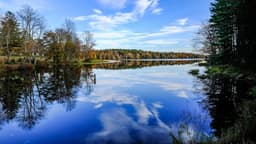Home / Environment / Azolla Algae Paints Eugene's Delta Ponds in Brilliant Red Hues
Azolla Algae Paints Eugene's Delta Ponds in Brilliant Red Hues
8 Oct
Summary
- Delta Ponds in Eugene turn bright red due to a beneficial aquatic fern called Azolla
- Azolla has a symbiotic relationship with cyanobacteria, helping it thrive and process carbon dioxide
- Azolla is a natural part of the ecosystem, providing food and habitat for wildlife

As the leaves begin to change color, signaling the arrival of autumn, the Delta Ponds in Eugene, Oregon have already undergone a stunning transformation. The 150-acre waterway has turned a brilliant shade of red, not due to falling foliage, but rather the growth of a unique aquatic fern called Azolla.
This red-brown fern, also known as "duck fern" or "mosquito fern," is a natural part of the Delta Ponds' ecosystem. According to Lauri Holts, the Parks and Open Spaces ecologist for the city of Eugene, Azolla has a symbiotic relationship with a type of cyanobacteria, allowing it to thrive and process carbon dioxide. This not only provides nutrients for the fern but also helps combat climate change by releasing oxygen into the water.
While the vibrant red patches may initially alarm some residents, Holts reassures that Azolla is a beneficial presence in the ponds. The fern serves as a food source for local wildlife, especially ducks and geese, and can even help reduce mosquito populations if it covers a significant portion of the water's surface.
As the weather warms and the sun shines brighter, the Azolla in the Delta Ponds will continue to flourish, painting the landscape in a stunning natural display that precedes the changing of the trees. This unique phenomenon is a testament to the delicate balance and resilience of the local ecosystem, which the city of Eugene is committed to preserving for years to come.




